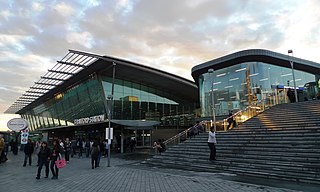
Stratford is a major multi-level interchange station serving the district of Stratford and the mixed-use development known as Stratford City, in the London Borough of Newham, East London for London Underground, London Overground, Docklands Light Railway (DLR) and Elizabeth line services. National Rail services also operate on the West Anglia Main Line and the Great Eastern Main Line, 4 miles 3 chains (6.5 km) from Liverpool Street.

Walthamstow Central is an interchange station located in Walthamstow in the London Borough of Waltham Forest for London Underground, London Overground and London Buses services.
The Northern & Eastern Railway (N&ER) was an early British railway company, that planned to build a line from London to York. Its ambition was cut successively back, and it was only constructed from Stratford, east of London, to the towns of Bishop's Stortford and Hertford. It was always short of money, and it got access to London over the Eastern Counties Railway (ECR). It was built at the track gauge of 5 ft, but it converted to standard gauge in 1844.

Tottenham Hale is an interchange station located in Tottenham Hale, North London for London Underground and National Rail services.

Northumberland Park railway station is on the Lea Valley line that forms part of the West Anglia Main Line, serving the ward of Northumberland Park in Tottenham, north London. It is 6 miles 73 chains (11.1 km) down the line from London Liverpool Street and is situated between Tottenham Hale and Meridian Water. Its three-letter station code is NUM and it is in Travelcard zone 3. It is one of the stations that can be used to access Tottenham Hotspur Stadium.

Wood Street is a railway station on the Chingford branch of the Lea Valley lines, located in Upper Walthamstow in the London Borough of Waltham Forest, north east London. It is 7 miles 7 chains (11.4 km) down the line from London Liverpool Street and is situated between Walthamstow Central and Highams Park. It has been operated by London Overground since 2015.
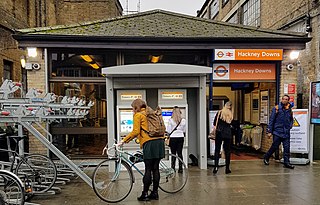
Hackney Downs is a London Overground and National Rail station in Hackney Central and serves the old common land of Hackney Downs in Lower Clapton in the London Borough of Hackney, it is on the Lea Valley lines and West Anglia Main Line. It is 2 miles 78 chains (4.8 km) down the line from London Liverpool Street and has a direct passenger link to Hackney Central station, providing interchange with the North London line of the Overground network.

Enfield Lock railway station is on the West Anglia Main Line, it is in Enfield Lock in the London Borough of Enfield, London. It is 11 miles 65 chains (19.0 km) down the line from London Liverpool Street and is situated between Brimsdown and Waltham Cross. Its three-letter station code is ENL and it is in Travelcard zone 6.

The Lea Valley lines are two commuter lines and two branches in north-east London, so named because they run along the Lower Lea Valley of the River Lea. They were part of the Great Eastern Railway, now part of the Anglia Route of Network Rail.

Broxbourne railway station is on the West Anglia Main Line serving the towns of Broxbourne and Hoddesdon in Hertfordshire, England. It is 17 miles 17 chains (27.7 km) down the line from London Liverpool Street and is situated between Cheshunt and Roydon. Its three-letter station code is BXB and it is in fare zone B.

Cheshunt is a National Rail and London Overground station in Cheshunt, Hertfordshire, England. On the National Rail network it is on the West Anglia Main Line, 14 miles 1 chain (22.6 km) from London Liverpool Street and situated between Waltham Cross and Broxbourne. On the London Overground network it is one of three northern termini of the Lea Valley lines.

Waltham Cross railway station is on the West Anglia Main Line, serving the suburban town of Waltham Cross in Hertfordshire, and the neighbouring Waltham Abbey in Essex, England. It is 12 miles 63 chains (20.6 km) down the line from London Liverpool Street and is situated between Enfield Lock and Cheshunt. Its three-letter station code is WLC and it is in Travelcard zone 7.

The West Anglia Main Line is one of the two main lines that operate out of Liverpool Street. It runs generally north through Cheshunt, Broxbourne, Harlow, Bishop's Stortford and Audley End to Cambridge, with branches between serving Stratford, Hertford and Stansted Airport. The line runs along the boundary between Hertfordshire and Essex for much of its length.
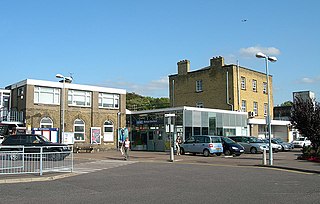
Bishop's Stortford railway station is on the West Anglia Main Line serving the town of Bishop's Stortford in Hertfordshire, England. It is 30 miles 27 chains (48.8 km) down the line from London Liverpool Street and is situated between Sawbridgeworth and Stansted Mountfitchet stations. Its three-letter station code is BIS.
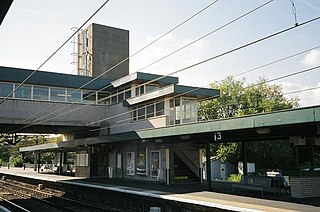
Harlow Town railway station is on the West Anglia Main Line serving the town of Harlow in Essex, England. It is 22 miles 59 chains (36.6 km) down the line from London Liverpool Street and is situated between Roydon and Harlow Mill stations. Its three-letter station code is HWN.
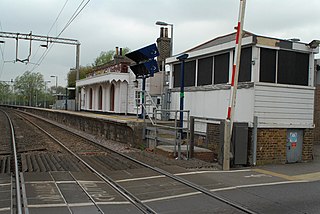
Roydon railway station is on the West Anglia Main Line serving the village of Roydon in Essex, England. It is 20 miles 9 chains (32.4 km) down the line from London Liverpool Street and is situated between Broxbourne and Harlow Town stations. Its three-letter station code is RYN.
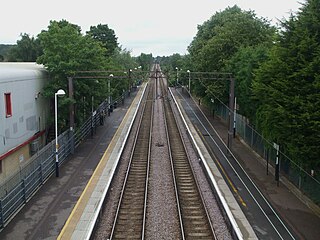
The Chingford branch line is a railway line between Clapton Junction and Chingford station. Services operate between Liverpool Street station and Chingford. The branch is part of the London Overground.

The Hall Farm Curve is a disused 500 m (1,600 ft) length of railway line in Walthamstow, East London, that connected Chingford station with Stratford station until the closure of the section of line in September 1968. The track was lifted in 1970.

The Southbury Loop is a line linking Edmonton Green, in north-east London, to Cheshunt. It was opened by the Great Eastern Railway in 1891. Initially it was not very successful and was closed to passenger traffic in 1909. Goods trains continued to use the line and during World War I passenger services were reinstated for munitions workers. Once the war finished the line returned to its goods-only status although it was occasionally used for diversionary purposes when the West Anglia Main Line was closed south of Cheshunt. Electrification of the line and the reintroduction of passenger services in 1960 saw the line become busy with regular suburban services as part of the Lea Valley Lines network. Since May 2015 passenger services on the line are part of London Overground.
Carterhatch Lane Halt was a railway station built by the Great Eastern Railway in 1916 on the Southbury Loop line to the north east of London in the United Kingdom. The Southbury Loop line was reopened in 1915 for passenger services for munitions workers to access factories in the Lea Valley area however the line closed in 1919.



















